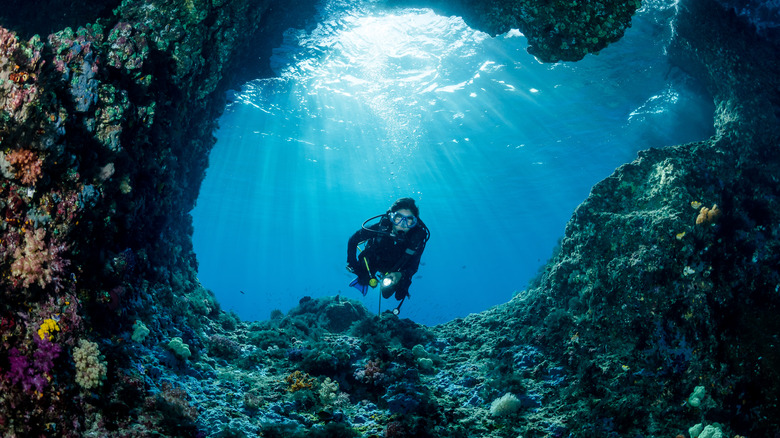This Underwater Cave Dive In America Is So Dangerous, Its Entrance Is Regulated
At surface level, the mouth of Diepolder's cave system suggests it's nothing more than a freshwater pond, overgrown with moss, reeds, and floating brambles. Few would suspect that the marshland pool would descend into a mysterious underwater cavern that reaches incredible depths of approximately 365 feet (although this number has been debated over the years, with publications citing varying depths). Located on the Sand Hill Ranch Scout Reservation in Hernando County, Florida, the caves are among the most unique in the Western Hemisphere. Despite their fame as some of the top-ranked diving spots, very few divers have seen the bottom of these limestone chambers.
This two-part cave system is divided into separate sinkholes, consisting of Diepolder II and III, with the latter recorded as slightly shallower, with a maximum depth of 300 feet. The harrowing caverns are recognized as one of the most dangerous cave dives in the world, with Diepolder II holding the record for the deepest cave in the continental U.S. Will Walters was the first to discover this rare underwater chamber, with Dale Sweet following in his footsteps in 1979 and reporting the maximum depth as only 360 feet. Future dives into these complex sinkholes revealed they stretched further than previously believed. To prevent drownings, the Diepolder caves are strictly regulated by the Florida Speleological Researchers (FSR) to ensure only the most experienced divers enter the caverns.
A test of bravery and strength
Even after mustering up the courage to descend under the murky waters of Diepolder's entrance, divers face several scary trials at varying depths that test their endurance and skill. One cavern section has even garnered the nickname "The Pit" because of its intimidating structure. The sheer depth of the cave system means even the faintest rays of sunlight cannot penetrate the darkness, making it challenging to navigate the underwater chambers. The endless black water, coupled with the complexity of the cave network, means that straying from the guide line is an easy mistake and can result in divers getting lost in the abyss.
Equally concerning is the extreme pressure that closes in on divers as they descend into the deepest parts of the cave. At depths as deep as Diepolder, divers use up their air 11 times faster than at surface level, meaning they must manage their air supply carefully to avoid running out of gas. Diving to these depths also requires a unique combination of gases suited for deep sites and contains a blend of helium, nitrogen, and oxygen. Deep sea divers often use this trimix gas blend to help prevent nitrogen narcosis, a serious and potentially fatal condition that induces intoxicating symptoms. The anesthetic effects of nitrogen narcosis can range from symptoms such as short-term memory loss and hallucinations to more severe cases, including comas (via Healthline).
This underwater cavern comes with strict qualifications
The quest for diving Diepolder's complex cave system is an extreme sport, to say the least, and is known for pushing divers to their limits. Encased within the cavern's limestone walls are the skeletal remains of sea creatures, a harrowing reminder of the area's dangers. At least two divers have lost their lives while exploring the caverns, with reported deaths in 1990 and 1999. According to the Tampa Bay Times, dive partners Dustin Clesi and Gordon Walker set out in 1991 on a deep dive expedition into Diepolder II that resulted in speculation about the depth of the chamber. While many publications attribute Diepolder II to having a maximum depth of around 360 feet, the Tampa Bay Times suggests potentially greater depths of 380 to 400 feet.
The Florida Speleological Researchers have placed strict limitations on this site to prevent future fatalities, ensuring only the most qualified divers enter these caverns. While nearly all cave sites require divers to have completed their cave diving certification through the National Association for Cave Diving, Diepolder's reputation as a deadly underwater trap has led to additional qualifications. Divers must also be trimix-certified and have completed a minimum of 100 cave dives after receiving proper training. Given the extreme depths of Diepolder II, extra precautions have been placed on this particular area. Divers are required to gain further experience in the shallower cavern before descending into the deeper chambers of the site. Only after completing at least three dives in Diepolder III can they attempt diving Diepolder II.


